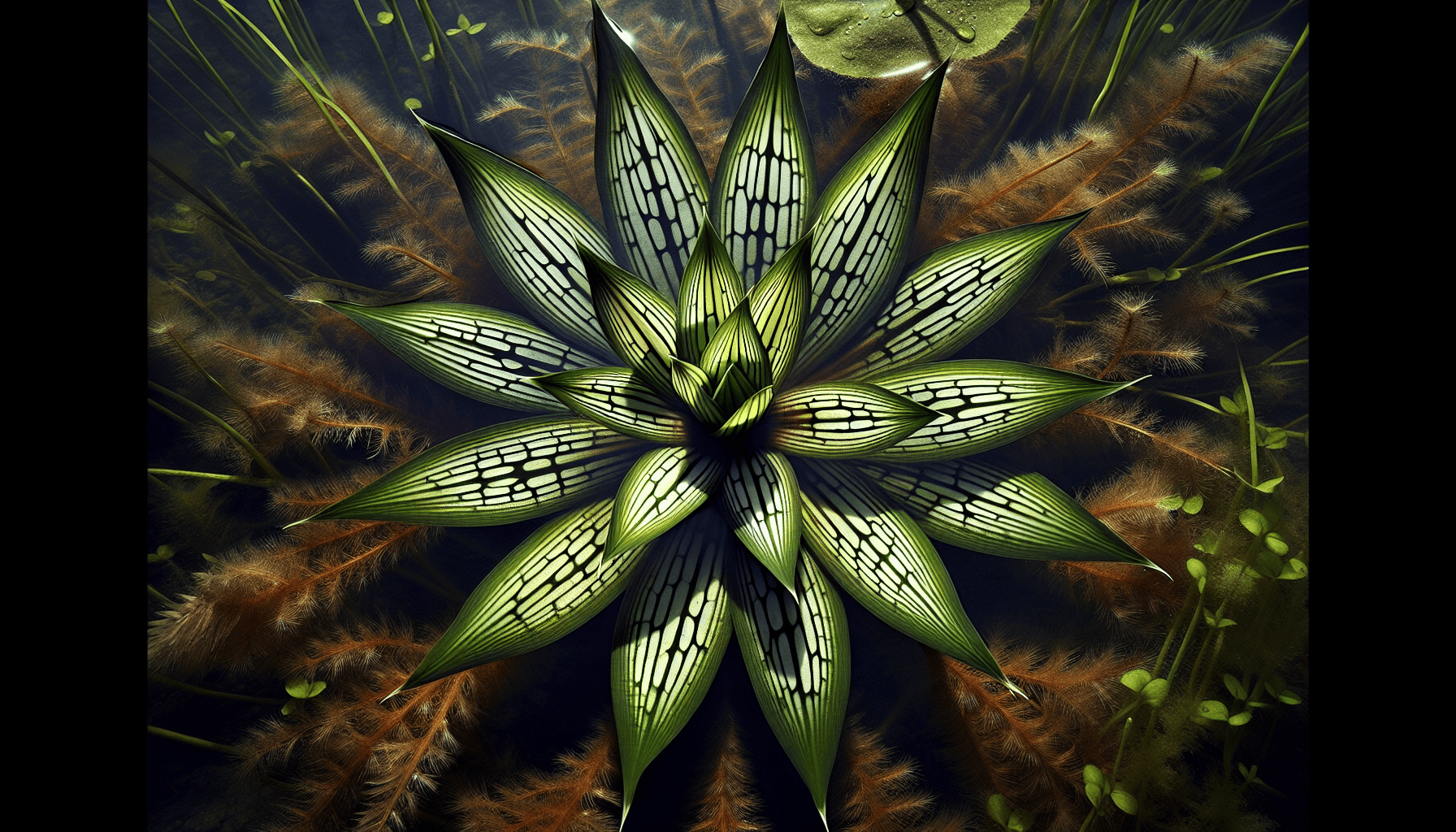In this scholarly discourse, you will marinate in the detailed exploration of the aquatic plant known as Engelmann’s Arrowhead. This plant, with its unique characteristics and singular habitat preferences, stands as an intriguing subject within the vastness of aquatic botany. As you venture forth into the intrinsic details of its morphology, taxonomy, and ecological significance, you’ll find your understanding of this peculiar species expanding, thereby enriching your comprehension of the role it serves within its intricate ecosystem. Thus, brace yourself for a fascinating study into Engelmann’s Arrowhead, penetrating the layers of scientific intrigue that this underappreciated aquatic plant offers.

Scientific Classification of Engelmann’s Arrowhead
Family and Genus
As a plant lover, you may be familiar with the scientific classification system used to identify different plant species. Engelmann’s Arrowhead belongs to the family Alismataceae. This family contains aquatic and semi-aquatic flowering plants, exhibiting exceptional adaptability to wet environments. The genus to which it belongs is Sagittaria, a broad group encompassing approximately 30 species. Sagittaria species are collectively referred to as ‘arrowheads’ due to their distinct leaf shape.
Species
The species represented by Engelmann’s Arrowhead is Sagittaria engelmanniana. The identifier “engelmanniana” is a tribute to George Engelmann, a prevalent 19th-century botanical figure known for his profound contributions to botanical taxonomy.
Common Names
The scientific nomenclature, while useful in professional contexts, might come across as intimidating to some. As such, Sagittaria engelmanniana is often referred to by its more accessible common names which include “Engelmann’s Arrowhead” and “Engelmann’s Duck-potato.”
Physical Description of Engelmann’s Arrowhead
Size and Shape
Engelmann’s Arrowhead plants typically attain heights of up to half a meter. They possess sturdy, unbranched stems that spring from a firm base. The name Arrowhead is derived from their characteristic leaf shape, featuring distinct arrow-shaped outlines with long petioles and a pointed apex.
Leaf Structure
Engelmann’s Arrowhead leaves are broad, veiny, and glossy. They have central veins that run from the stem to the point of the arrowhead. Aside from this, the leaves have excellent hydrophobic properties, shedding water with ease and preventing unnecessary water uptake.
Color
The lush, green leaves of Engelmann’s Arrowhead provide a vibrant color contrast in its aquatic habitat. During the blooming period, beautiful white flowers sprout at the end of long stalks, adding to the visual appeal of this plant.
Flowering Structure
Engelmann’s Arrowhead’s flowering structure, or inflorescence, is composed of whorls of 3-petaled white flowers. Each flower adorns three sepals and several bright yellow stamens in its center, creating a delightful display.
Habitat and Distribution
Geographical Distribution
Engelmann’s Arrowhead is predominantly found across North America. Its distribution stretches from the Canadian provinces of Ontario and Quebec, down to the United States’ southeastern and midwestern regions.
Preferred Ecosystem
Being an aquatic plant, Engelmann’s Arrowhead primarily thrives in freshwater habitats. These include marshes, swamps, floodplain forests, and the margins of ponds and lakes.
Growing Conditions
Engelmann’s Arrowhead prefers sunny to partially shady conditions. It flourishes in wet soil or water bodies with slow-moving or still water. The soil should preferably be clay, loam, or sand and must retain moisture well.

Life Cycle and Growth
Germination
Like many aquatic plants, Engelmann’s Arrowhead produces a type of fruit known as an achene which houses the seeds. Germination occurs underwater, where the seeds are initially dispersed.
Growth Stages
Engelmann’s Arrowhead follows a seasonal growth pattern. It initiates its growth and development in spring, matures during summer, and seeds in late summer or early autumn. Following seed dispersion, the plant’s above-ground parts wither away, leaving behind the robust rhizome to survive winter and spawn new growth in the subsequent spring.
Blooming Period
The blooming period of Engelmann’s Arrowhead generally falls during summer. The plants sprout tall stalks bearing clusters of delicate white flowers that persist for several weeks.
Reproductive System
Engelmann’s Arrowhead, being a monoecious plant, produces both male and female flowers on the same plant. Fertilization occurs through cross-pollination, facilitated by insects and wind.
Ecological Role of Engelmann’s Arrowhead
Role in the Ecosystem
Engelmann’s Arrowhead plays a crucial ecological role by providing shelter and food for aquatic insects, birds, and small mammals.
Interactions with Other Species
The plant’s tall and robust stalks are often used by birds to anchor their nests. Moreover, the seeds and tubers serve as food sources for several animal species.
Impact on Water Quality
As a riparian plant, Engelmann’s Arrowhead aids in improving water quality. It does this by filtering runoff and reducing erosion along the water body’s edge, thereby preventing sedimentation and nutrient overload in the water.
Conservation Status
Current Conservation Status
Engelmann’s Arrowhead is classified as a least concern species due to its broad distribution and capacity to survive in diverse habitats.
Threats to Survival
However, habitat loss due to urbanization, land conversion for agriculture, and pollution present considerable threats to the survival of this species.
Conservation Efforts
Efforts to conserve this plant species involve habitat restoration, regulation of hunting, and control of invasive species that threaten its existence.
Engelmann’s Arrowhead Propagation and Cultivation
Ideal Cultivation Conditions
Cultivation of Engelmann’s Arrowhead is well-suited to wet soils or shallow water bodies with full to partial sun exposure.
Propagation Methods
The plant is easily propagated through seeds or by dividing the rhizomes in late spring or early summer.
Common Challenges in Cultivation
One of the common challenges in cultivating Engelmann’s Arrowhead is its susceptibility to pests like aphids and snails. Preventative practices, including regular monitoring, are recommended.
Uses and Benefits of Engelmann’s Arrowhead
Traditional Uses
Engelmann’s Arrowhead has traditionally been used by indigenous communities as a food source. The starchy tubers are edible and have been consumed both raw and cooked.
Potential Medicinal Properties
While there is limited scientific research, some traditional medicinal practices have cited Engelmann’s Arrowhead for its potential medicinal properties, notably as a diuretic and astringent.
Landscaping Purposes
With its aesthetically pleasing flowers and leaves, Engelmann’s Arrowhead is also popular for water garden landscapes and aquatic ornamental purposes.
Concerns and Possible Hazards
Invasive Potential
Although it is beneficial and beautiful, one should be cautious of Engelmann’s Arrowhead’s invasive potential, as it can quickly overtake a water body if conditions are favorable.
Potential Hazards to Humans or Animals
Ingesting large uncooked quantities of Engelmann’s Arrowhead can cause digestive issues in both humans and animals due to the presence of calcium oxalate crystals.
Management of Invasive Populations
Effective management of invasive populations includes regular monitoring, strategic harvesting, and careful control of water flow to prevent unchecked propagation.
Interesting Facts about Engelmann’s Arrowhead
Taxonomic History
Engelmann’s Arrowhead is named after George Engelmann, a renowned botanist who made significant strides in plant taxonomy during the 19th century.
Unique Features
The plant’s striking arrowhead-shaped leaves give it a unique silhouette against the backdrop of an aquatic landscape.
Historical Significance
The edible tubers of Engelmann’s Arrowhead have been historically significant as a source of food for indigenous communities across its geographical distribution.